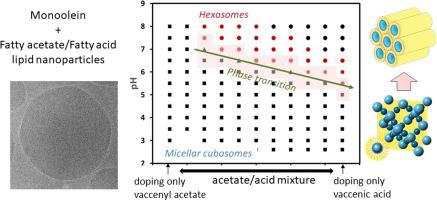Journal of Colloid and Interface Science ( IF 9.4 ) Pub Date : 2021-09-02 , DOI: 10.1016/j.jcis.2021.08.173 Jiali Zhai 1 , Sue Lyn Yap 1 , Calum J Drummond 1 , Nhiem Tran 1

|
Hypothesis
Cubosomes made from the inverse micellar cubic mesophase (I2) with Fd3m symmetry possess a unique structure of closely packed inverse micelles. These have prospective functionality in sustained drug release. In this study, we hypothesised that similar to fatty acids, various fatty acetate compounds can induce the formation of micellar Fd3m cubosomes in monoolein (MO) nanoparticles. They are different to micellar cubosomes made of MO and a fatty acid, which are pH responsive and can transition from an Fd3m phase to an inverse hexagonal phase (H2) as pH increases. We hypothesised that by co-doping a fatty acetate and fatty acid into MO, precise control of the Fd3m–H2 phase transition pH in nanoparticles can be achieved.
Experiments
Five unsaturated fatty acetates with hydrocarbon chain lengths between 18 and 24 were added to MO at a weight ratio of 0.45 – 0.60 to form nanoparticles. The nanoparticles were prepared using high-throughput formulation and characterised with synchrotron small angle X-ray scattering (SAXS). MO nanoparticles doped with vaccenyl acetate and vaccenic acid were used to demonstrate the fine control over Fd3m–H2 phase transition pH.
Findings
Micellar cubosomes (Fd3m phase) were found in MO nanoparticles doped with fatty acetates. The Fd3m structure was stable in a wide pH range of 2.6 – 8 and at temperatures up to 45 °C. In MO nanoparticles doped with the acetate/acid mixture, the Fd3m–H2 phase transition pH was tuned between pH 5 and pH 7 by adjusting the ratio of vaccenyl acetate and vaccenic acid. As a H2 phase generally offers faster drug release than an Fd3m phase, the pH responsive lipid nanoparticles developed here may find application in orally administrated formulation, where the vehicles must pass a low pH environment in the stomach before reaching neutral pH in the blood.
中文翻译:

使用脂肪酸乙酸酯和脂肪酸添加剂混合物控制单油精 Fd3m 胶束立方体和己糖体之间的 pH 依赖性转变
假设
由具有 Fd3m 对称性的反胶束立方中间相 (I 2 )制成的立方体具有独特的紧密堆积的反胶束结构。这些在持续药物释放方面具有前瞻性功能。在这项研究中,我们假设与脂肪酸类似,各种脂肪酸乙酸酯化合物可以诱导油酸甘油酯 (MO) 纳米颗粒中胶束 Fd3m 立方体的形成。它们与由 MO 和脂肪酸制成的胶束立方体不同,胶束立方体对 pH 值敏感,并且可以随着 pH 值的增加从 Fd3m 相转变为反六方相 (H 2 )。我们假设通过将脂肪酸乙酸酯和脂肪酸共掺杂到 MO 中,可以实现对纳米颗粒中Fd3m-H 2相变 pH 值的精确控制。
实验
将烃链长度在 18 到 24 之间的五种不饱和脂肪酸乙酸酯以 0.45 – 0.60 的重量比添加到 MO 中以形成纳米颗粒。纳米粒子是使用高通量配方制备的,并用同步加速器小角 X 射线散射 (SAXS) 进行表征。掺杂有醋酸乙烯酯和异油酸的 MO 纳米颗粒用于证明对 Fd3m-H 2相变 pH 值的精细控制。
发现
在掺杂有脂肪酸乙酸酯的 MO 纳米颗粒中发现了胶束立方体(Fd3m 相)。Fd3m 结构在 2.6 – 8 的宽 pH 范围内和高达 45 °C 的温度下是稳定的。在掺杂有醋酸盐/酸混合物的 MO 纳米粒子中,通过调节醋酸异油酸和异油酸的比例,Fd3m-H 2相变 pH 值在 pH 5 和 pH 7 之间进行调节。由于 H 2相通常比 Fd3m 相提供更快的药物释放,因此此处开发的 pH 响应脂质纳米颗粒可用于口服制剂,其中载体必须通过胃中的低 pH 环境,然后才能达到血液中的中性 pH。











































 京公网安备 11010802027423号
京公网安备 11010802027423号